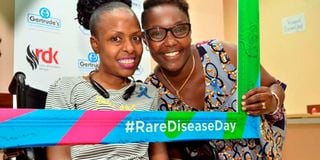Rare diseases: Small numbers, huge burden

What you need to know:
- According to Rare Disease International, the official international awareness-raising campaign for rare diseases and conditions takes place on the last day of February each year.
- The main objective of the campaign is to raise awareness among the general public and decision-makers about the diseases and their impact on patients’ lives.
The theme of this year’s World Rare Disease Day, which was commemorated on Monday, was ‘share your colours’. It urges people around the world to share videos and photos from their rare disease day events on social media using #RareDiseaseDay and tagging @rarediseaseday on Instagram and Twitter.
According to Rare Disease International (RDI), the official international awareness-raising campaign for rare diseases and conditions takes place on the last day of February each year.
The campaign observes that there are 300 million people living with a rare disease worldwide and over 6,000 different rare diseases These only include the ones that have been discovered. Further, there are thousands of people living with rare diseases without proper diagnosis, let alone treatment..
“72 per cent of rare diseases are genetic while 70 per cent of those genetic rare diseases start in childhood.”
The main objective of the campaign is to raise awareness among the general public and decision-makers about the diseases and their impact on patients’ lives.
It was launched by EURORDISRare Diseases Europe and its Council of National Alliances in 2008.
“We work towards more equitable access to diagnosis, treatment, care and social opportunity,” the official site highlights. They advocate to policy-makers that people living with a rare disease need equitable access to diagnosis, treatment and care as part of Universal Health Coverage. On December 16, 2021, the United Nations (UN) adopted the first-ever UN Resolution on addressing the challenges of persons living with a rare disease and their families.
“Recognising the need to promote and protect the human rights of all persons, including the estimated 300 million persons living with a rare disease worldwide, many of whom are children, by ensuring equal opportunities to achieve their optimal potential development and to fully, equally and meaningfully participate in society. Reaffirming the right of every human being, without distinction of any kind, to the enjoyment of the highest attainable standard of physical and mental health and to a standard of living adequate for the health and well-being of oneself and one’s family, including adequate food, safe drinking water, clothing and housing, and to the continuous improvement of living conditions, with particular attention to the alarming,” the UN stated in its official document.”





